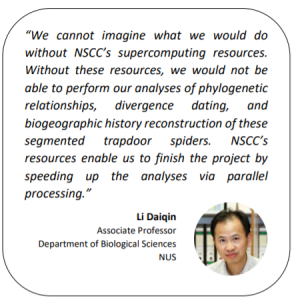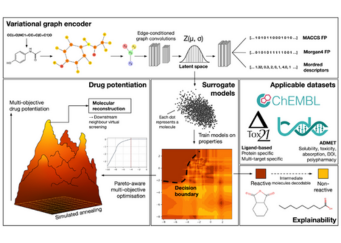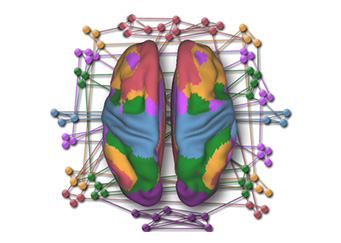NSCC’s supercomputer is being used to accelerate the analysis of the evolutionary history and biogeography of ‘ancient’ trapdoor spiders so that they can be used as a model system to look at how geology and climate help shape the biodiversity in the region.
Southeast Asia (SEA) is renowned for its strikingly high biodiversity and endemism, and contains four (IndoBurma, Sundaland, Wallacea, and the Philippines) of the 34 global biodiversity hotspots due to the region’s complex geological and climatic histories. However, these are increasingly under threat leading to huge efforts to conserve its biodiversity.
The conservation of biodiversity in the SEA region cannot be fully understood without considering the region’s complex geology and climate. Three major outstanding problems have impeded the understanding of SEA’s diversity patterns – 1) how geological and climatic processes have driven species diversification across SEA is still not well understood; 2) prior studies of SEA biodiversity and biogeography have primarily focused on vertebrates yet few studies have explored diversification and biogeography of invertebrates, ancient lineages, poor dispersers, pre-Pleistocene vicariance, and/or large areas within SEA; 3) elucidating well-supported phylogenies necessary for reconstructing evolutionary and biogeographic histories has been shown to be challenging for a variety of taxa including spiders, even when multiple loci are used.
 A team of researchers at the Department of Biological Sciences, NUS, is utilising NSCC’s high performance computing resources (HPC) to investigate the evolutionary history and biogeography of primitively segmented trapdoor spiders by performing phylogenomic and molecular dating analyses based on the genome-scale data comprising over 2,000 ultraconserved element loci. These spiders belong to the family Liphistiidae and are considered as “living fossils” because they are the sole surviving lineage in the suborder Mesothelae, which forms the sister lineage to all other extant spiders such as tarantulas and black widow spiders. Thus, the team aims to use these spiders as a model system to test how geological and climatic events have shaped SEA biodiversity. Additionally, studying this group has the potential to shed light on the deep evolutionary history of spiders and also other eight-legged animals.
A team of researchers at the Department of Biological Sciences, NUS, is utilising NSCC’s high performance computing resources (HPC) to investigate the evolutionary history and biogeography of primitively segmented trapdoor spiders by performing phylogenomic and molecular dating analyses based on the genome-scale data comprising over 2,000 ultraconserved element loci. These spiders belong to the family Liphistiidae and are considered as “living fossils” because they are the sole surviving lineage in the suborder Mesothelae, which forms the sister lineage to all other extant spiders such as tarantulas and black widow spiders. Thus, the team aims to use these spiders as a model system to test how geological and climatic events have shaped SEA biodiversity. Additionally, studying this group has the potential to shed light on the deep evolutionary history of spiders and also other eight-legged animals.
To find out more about the NSCC’s HPC resources and how you can tap on them, please contact [email protected].
NSCC NewsBytes February 2021
Other Case Studies
Advancing Drug Discovery Research using NSCC HPC resources
Researchers from Nanyang Technological University (NTU) are applying variational graph encoders as an effective generalist algorithm in computer-aided drug design (CADD)....
Gaining Deeper Insights into Mental Disorders through Brain Imaging and High-Performance Computing
Researchers from NUS are leveraging supercomputing to develop better strategies for prevention and treatment to mitigate the impact of mental illness. The human brain is a marvel...
Using Digital Twin Technology to Optimise the Industrial 3D Printing Process
Researchers from the Institute of High-Performance Computing (IHPC) are utilizing supercomputers to create a digital twin that furnishes users with comprehensive information...


